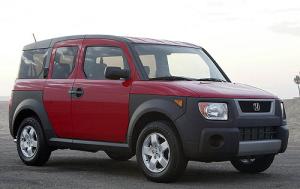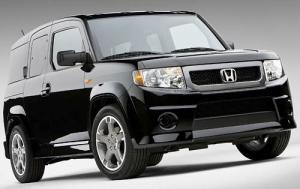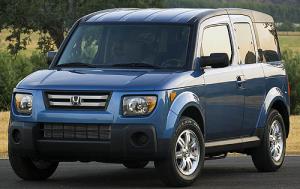
While historically high new and used car prices have forced many buyers to look for "older" vehicles that have aged well as a way of saving money, the issues of reliability and dependability have become even more crucial.
So, how has the Honda Element fared over time? Have well-maintained, older Element models aged well? History has proven that, yes, many Honda Elements have proven to be quite reliable, but there have been exceptions and virtually all vehicles can have problems, even Hondas.
Therefore, here, ...
- First, we'll look at the reliability history for the Honda Element.
- We'll then list possible mechanical issues that have been reported by some owners so they can be checked before buying one today.
- Then we'll do an overview of the Element's features and characteristics so potential buyers can get to know the vehicle better.
- And then we'll review the overall pros and cons of buying a Honda Element today, all these years later.
Honda Element Reliability
Produced for the 2003 - 2011 models years, the Honda Element has generally proven to be a reliable vehicle, with many owners reaching 200,000 miles or more without major issues. It is a Honda, after all.
That said, some mechanical issues have been reported by owners, like any vehicle. In addition, some model years have proven to be more reliable than others.
Some points to consider:
Model years to avoid: 2003, 2004, 2007, and 2008, due to more reported problems with the engine or transmission.
More reliable model years: 2005, 2006, 2009, 2010, and 2011, with fewer reported issues.
Maintenance costs: estimated at $491 per year, they are lower than average for compact SUVs.
Possible Honda Element Mechanical Problems
The Honda Element has had a number of mechanical problems reported by some owners which should therefore be included in an inspection prior to buying:
Automatic transmission failures: One of the most significant issues was with the automatic transmissions, especially in the 2003-2004 models. Problems included slipping, rough shifting, and complete transmission failure, often requiring costly repairs or replacements.
Variable timing control solenoid failure: One of the main mechanical issues with the Element was a variable timing control solenoid failure, which caused major oil leaks in most cases.
Airbag problem: It’s one of the most frequent complaints for the Honda Element, and it’s not just this model, but also a problem of other Honda models of that period. Most have been recalled by now, however.
You May Also Like:
Best Used Cars For Reliability
All About Wholesale Car Prices
Unstable rear tailgate: Several Element owners reported that their rear hatch light turns on by itself randomly.
Malfunctioning door locks: There have been some reports that door locks have malfunctioned.
Key won’t turn in the ignition: This issue was mostly limited to the 2003 model.
Suspension problems: Some owners reported issues with the suspension system, particularly with the struts and shocks. Premature wear and failure of these components were experienced, leading to a bumpy ride.
Engine issues: Some models experienced engine problems, such as excessive oil consumption and engine block cracks. The 2.4-liter i-VTEC engine had a tendency to burn oil, particularly in higher-mileage vehicles.
Electrical problems: There were various electrical issues reported, including problems with the ignition switch, which could cause the engine to stall unexpectedly. Additionally, some owners faced issues with the power window regulators.
Air conditioning system failures: The air conditioning system in some models experienced failure, particularly with the AC compressor.
PSRS (Supplemental Restraint System) light: Some owners encountered issues with the SRS light illuminating due to faulty seat belt buckles or sensor issues. This required attention to ensure that the airbags would deploy correctly in the event of a collision.
These issues varied in severity and occurrence, with some owners experiencing minimal problems and others encountering multiple issues. Despite these mechanical problems, the Honda Element has been generally well-regarded for its reliability, practicality, unique design, and versatility.
Honda Element Overview

Even though it is now out of production, the Honda Element has an awful lot going for it. It's got a totally unique look, it's spacious, it's highly functional ... and it's a "Honda", which means it's a top quality vehicle, so there are still quite a few floating around out there despite the years.
Initially, it was intended to attract mostly outdoor, athletic types such as cyclists, surfers and so forth. But it turned out it appealed to city folks as well thanks to its spacious cabin, competent drive, and easy parking.
Originally based on the Honda CR-V, the Element successfully debuted in 2003 (and was produced through 2011) with its novel interior touches and unique wagon design.
With center-opening side doors, and without center body pillars, the Element was slightly taller, wider and heavier (by about 200 pounds) than the CR-V. And like the CR-V, it was equipped with a four-cylinder engine, as well as manual and automatic transmission choices.
The Element is also available in either front-wheel or all-wheel drive forms, without low-range gearing. And rather than a traditional swing-out rear door with a glass hatch, the Element sports a combination upper liftgate and drop-down tailgate.
In addition, the Element's rear-hinged back doors are shorter than those in the front and can not be opened independently.
The Element seats four occupants on front bucket seats and a split bench rear seat. Weighing just 30 pounds, sections of the back bench can be swung up to the side or even totally removed for still more cargo space. AWD models include a tilt or removable glass skylight over the cargo bay.
At the outset, the Element was powered by a 156-horsepower 2.4-liter four-cylinder engine that was paired with either a 5-speed manual transmission or a 4-speed automatic. For 2007, this same engine got a power boost to 166-hp.
Gas mileage performance is a bit uninspiring, however, for a four cylinder engine, ranging from an EPA-estimated 20 mpg city and 25 mpg highway on two-wheel-drive models with an automatic transmission, to 18 mpg city and 23 highway for manual-transmission AWD models.

Base DX Element models were primarily produced for individual owner personalization, even coming without a factory audio. These can be found in the secondary market with a wide array of different features.
The more uplevel EX model features a 270-watt CD audio system, cruise control, air conditioning, power mirrors, alloy wheels and a two-tone interior trim.
Both the DX and EX models have a rubberlike textured floor, water-resistant cloth upholstery, 16-inch wheels and four-wheel disc brakes. EX models come with standard ABS brakes and some pre-2007 models can be found with the optional front side airbags.
Honda Element shoppers should note that it received only minor feature upgrades through the 2006 model year, however, there were more significant changes in 2007. Power was boosted by 10 horses, the SC trim level was introduced and the automatic transmission was upgraded to a more efficient five-speeds (earlier models had a four-speed automatic).
The Element SC model was a sportier version with a lowered sport suspension, copper-colored gauges, 18-inch alloy wheels, body-colored bumpers, and projector beam headlights.
Also in 2007, stability control and side airbags became standard, while a new navigation system was offered for 2009.
For 2010, the Dog Friendly package was introduced and included an enclosed kennel with a bed and water bowl.
The Element's final year of production, 2011, saw the models trimmed to just LX and EX, while both the manual transmission and optional navigation system were dropped.
Overall, the Element offers a roomy cabin, a smooth four-cylinder power, well-balanced handling, plenty of versatility, distinctive styling, four-wheel-drive availability, easy cargo loading, and Honda's reputation for reliability.
On the downside, it seats only four, it's fuel economy is disappointing by today's standards, and its acceleration is unimpressive.
Potential buyers may want to stick to 2007 and newer models due to their increased power and additional safety features.
Pros And Cons of Buying a Honda Element Today
Pros:
Affordability: As an older vehicle, the Element can be relatively affordable compared to newer SUVs and crossovers. Its depreciation has leveled off, making it a cost-effective option.

Reliability: Honda is known for building reliable vehicles, and many Elements have proven to be long-lasting with proper maintenance. The engine and transmission, if well-cared for, can deliver many miles of reliable service.
Versatile Interior: The Element is known for its highly configurable and spacious interior. The rear seats can be removed or folded flat to create a large cargo area, making it ideal for transporting gear, pets, or other bulky items.
Durable Design: The boxy design of the Element provides good visibility and makes it easy to maneuver. The interior materials, including the waterproof seating and flooring, are designed to be durable and easy to clean.
Unique Style: The Element's distinctive, boxy shape and quirky design elements set it apart from other vehicles. Its unique look can be appealing to those who want a car that stands out.
Good Visibility: The large windows and upright driving position offer excellent visibility, which is a safety advantage and makes the Element easier to drive in various conditions.
Cons:
Age and Wear: The newest first-generation Elements are over a decade old, so potential buyers need to be aware of age-related wear and tear. This includes rust, especially in areas with harsh winters, and degradation of rubber components.
Common Mechanical Issues: As outlined earlier, the Element has had some known issues which could pose a risk of repair costs offsetting some or all of the upfront cost savings. Buyers should ensure these issues have been addressed or be prepared for potential repairs.

Fuel Economy: The Element's fuel economy is not as competitive by modern standards. It typically averages around 20-25 mpg, which is lower than many newer crossovers and SUVs.
Limited Features: Compared to modern vehicles, the Element lacks many of the advanced features and technology found in newer cars, such as advanced driver assistance systems (ADAS), modern infotainment systems, and more efficient powertrains.
Parts Availability: While many parts are still available, some specific components may become harder to find or more expensive as the vehicle ages. This could lead to longer repair times and increased costs for certain repairs.
Ride Quality: The Element's ride quality can be stiff and bouncy due to its utilitarian design and suspension setup. It may not be as comfortable on long trips or rough roads compared to more modern vehicles.
 By Josh Rosenberg
By Josh Rosenberg